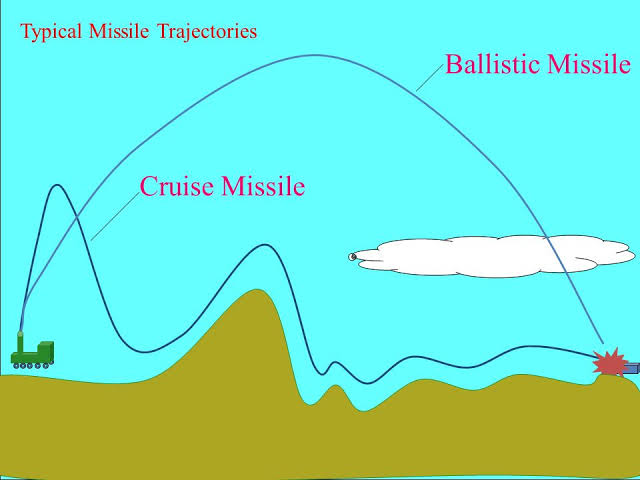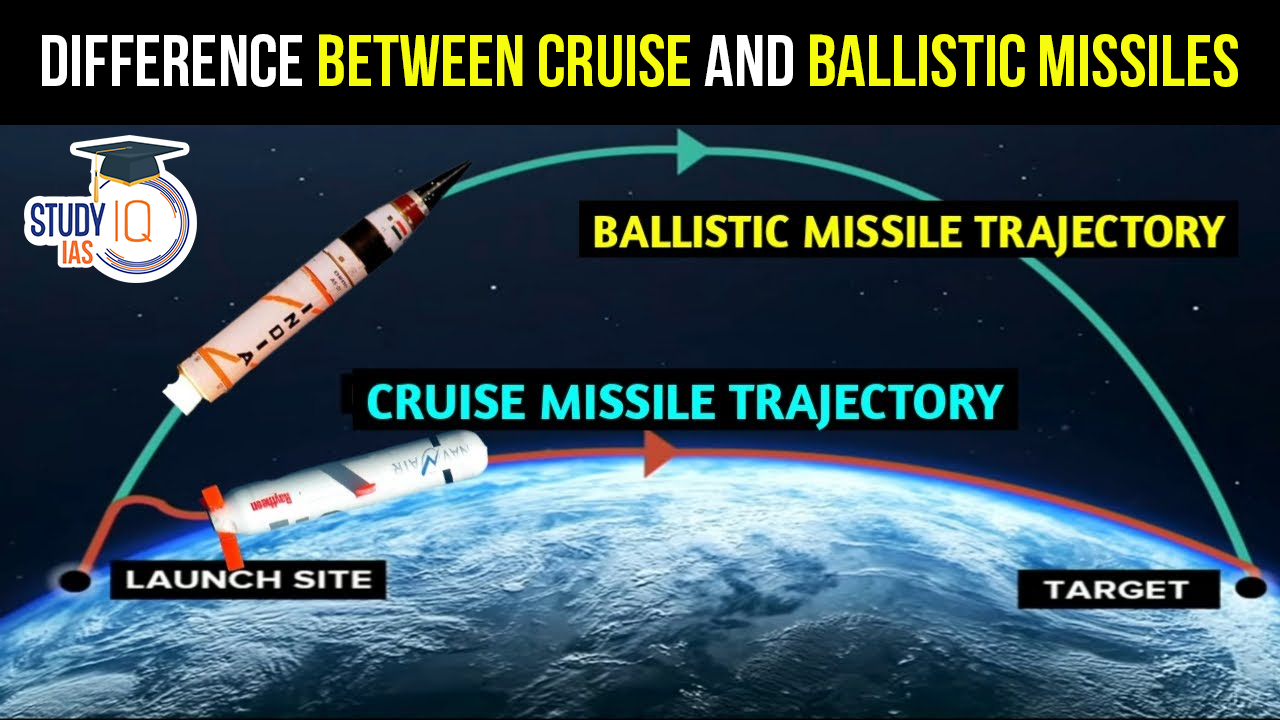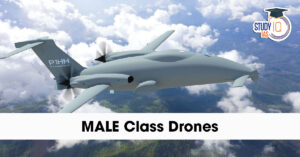Table of Contents
India’s nuclear doctrine is a significant aspect of its national security policy, formulated to ensure credible deterrence and regional stability. The doctrine is rooted in India’s commitment to “No First Use” (NFU) and a defensive nuclear posture. In this article, we will explore the key elements of India’s nuclear doctrine, its historical context, and its relevance to India’s security strategy, as well as the Difference between Cruise and Ballistic Missiles in detail.
Cruise Missiles
Cruise missiles are self-propelled, guided weapons that can be launched from various platforms, including aircraft, ships, or ground-based launchers. They are designed to fly at low altitudes and can be programmed to follow a specific flight path, often hugging the terrain, which makes them difficult to detect and intercept. Cruise missiles can carry various types of warheads and are used for precise, long-range strikes on specific targets, such as military installations, infrastructure, or high-value targets. Their ability to navigate and adapt during flight provides them with a high degree of accuracy.
Examples of Cruise missiles
- Tomahawk: The United States Navy’s Tomahawk cruise missile is one of the most well-known examples. It’s used for long-range precision strikes and can be launched from ships and submarines.
- BrahMos: A joint venture between India and Russia, the BrahMos cruise missile is one of the fastest supersonic cruise missiles in the world.
- AGM-86 ALCM: The United States Air Force employs the AGM-86 Air-Launched Cruise Missile as a nuclear-armed cruise missile.
- Storm Shadow / SCALP: Developed by France and the UK, this air-launched cruise missile is used for precision strikes against high-value targets.
- Kalibr: A family of cruise missiles used by Russia, including anti-ship, land-attack, and anti-submarine variants.
- JASSM: The Joint Air-to-Surface Standoff Missile, used by the United States and several other countries, is designed for precision strikes against high-value, well-defended targets.
We’re now on WhatsApp. Click to Join
Ballistic Missiles
Ballistic missiles are unguided rockets that follow a high, parabolic trajectory when launched, ascending into space and then descending rapidly toward their target. They can carry nuclear or conventional warheads and are categorised based on their range: short-range, medium-range, intermediate-range, and intercontinental-range missiles.
Ballistic missiles are known for their high speed and long-range capabilities, making them suitable for delivering strategic or long-range strikes. Unlike cruise missiles, they lack in-flight manoeuvrability but rely on their high velocity and trajectory to reach their intended targets. They are a key component of many countries’ military arsenals.
Examples of Ballistic Missiles
- Intercontinental Ballistic Missile (ICBM): The Minuteman III ICBM used by the United States is a prime example, designed for delivering nuclear payloads over intercontinental distances.
- Submarine-Launched Ballistic Missile (SLBM): The Trident II D5, used by the U.S. Navy, is an example of an SLBM capable of being launched from submarines.
- Medium-Range Ballistic Missile (MRBM): The Russian Iskander-M is an MRBM used for shorter-range precision strikes.
- Short-Range Ballistic Missile (SRBM): The North Korean Hwasong-15 is an example of an SRBM with an extended range, designed for regional threats.
- Intermediate-Range Ballistic Missile (IRBM): The Chinese DF-26 is an example of an IRBM designed for regional and strategic purposes.
Difference Between Cruise and Ballistic Missiles
Here you can check the major Differences Between Cruise and Ballistic Missiles:
| Aspect | Cruise Missiles | Ballistic Missiles |
| Propulsion | Air-breathing (jet or propeller-driven) | Rocket-powered |
| Speed | Subsonic or supersonic (slower) | Supersonic to hypersonic (much faster) |
| Flight Altitude | Low, near the Earth’s surface | High, often into space and then descent |
| Guidance | Guided throughout the entire flight | Guided only during the boost phase |
| Maneuverability | The high degree of in-flight manoeuvrability | Limited manoeuvrability |
| Range | Typically longer range | Varies but often longer range, especially ICBMs |
| Targeting Accuracy | High precision due to guidance | Less precise due to the ballistic trajectory |
| Launch Platforms | Various platforms, including ships, submarines, aircraft, and ground-based launchers | Mainly land-based, submarine-based, and some road-mobile launchers |
| Tactical Use | Precision strikes on specific targets (e.g., military installations, infrastructure) | Strategic, long-range attacks on cities, military bases, or other nations |
| Detectability | Harder to detect due to low altitude and smaller radar cross-section | Easier to detect during the boost phase |
| Warhead Types | Can carry various types, including conventional and nuclear warheads | Typically used for nuclear warheads, but can also carry conventional warheads |
| In-Flight Guidance Updates | Can receive updates during flight, allowing for course changes | Generally pre-programmed with no updates during flight |
| Examples (India) | BrahMos, Nirbhay | Prithvi I, Prithvi II, Agni I, Agni II and Dhanush missiles. |
Ballistic vs. Cruise Missiles

Ballistic Missiles
| Classification based on Range | Characteristics | Flight Stages |
| Short-range (Tactical) | < 1,000 km | Boost Phase: Initial rocket-powered ascent, typically lasting 3-5 minutes in the atmosphere. |
| Medium-range (Theater) | 1,000 – 3,000 km | Midcourse Phase: The Missile continues to ascend, reaches the highest point, and begins descent. This is the longest phase. |
| Intermediate-range | 3,000 – 5,500 km | Terminal Phase: Detached warhead(s) reenter the Earth’s atmosphere and impact or detonate. |
| Long-range (Strategic/ICBM) | > 5,500 km | For ICBMs, the midcourse phase can last around 20 minutes, with speeds of around 24,000 km/h. |
Cruise Missiles
| Characteristics | Propulsion | Flight Altitude | Guidance | Flight Path |
| Unmanned, propelled by jet engines | Jet engines | Low altitude, within the atmosphere | Self-guided, using GPS, terrain mapping, and inertial guidance | Pre-programmed flight path, with remote operator guidance options near the target. |
Relevance of India’s Nuclear Doctrine
Security and Defence Policy:
- Understanding India’s nuclear doctrine is crucial for aspirants preparing for the International Relations and Security sections of the UPSC syllabus. It reflects India’s defence strategy, its approach to regional stability, and its role in the global nuclear order.
International Relations:
- India’s nuclear policy has profound implications for its relations with neighbouring countries such as China and Pakistan. It also plays a role in India’s stance at international forums like the Nuclear Non-Proliferation Treaty (NPT) and Comprehensive Nuclear-Test-Ban Treaty (CTBT) negotiations.
Global Nuclear Disarmament:
- Aspirants must be aware of India’s dual approach: maintaining a credible deterrent while advocating for global nuclear disarmament. This reflects India’s aspirations for leadership in global peace efforts.
Nuclear Triad and Defence Capabilities:
- A working knowledge of India’s defence capabilities, including its nuclear triad, delivery systems, and missile programs (such as Agni, Prithvi, and K-4/K-15 missiles), is essential for understanding India’s strategic posture.
Conclusion
India’s nuclear doctrine is a reflection of its commitment to peace, deterrence, and global disarmament. While it faces strategic challenges from its neighbours, India’s stance on “No First Use” and maintaining credible minimum deterrence underscores its responsible nuclear policy. For UPSC aspirants, understanding India’s nuclear doctrine is crucial for comprehending India’s overall security and defence policies and how they impact regional and global stability.


 Genetically Modified Crops in India, Reg...
Genetically Modified Crops in India, Reg...
 What are Polycyclic Aromatic Hydrocarbon...
What are Polycyclic Aromatic Hydrocarbon...
 MALE Class Drones: Capabilities, Payload...
MALE Class Drones: Capabilities, Payload...





















